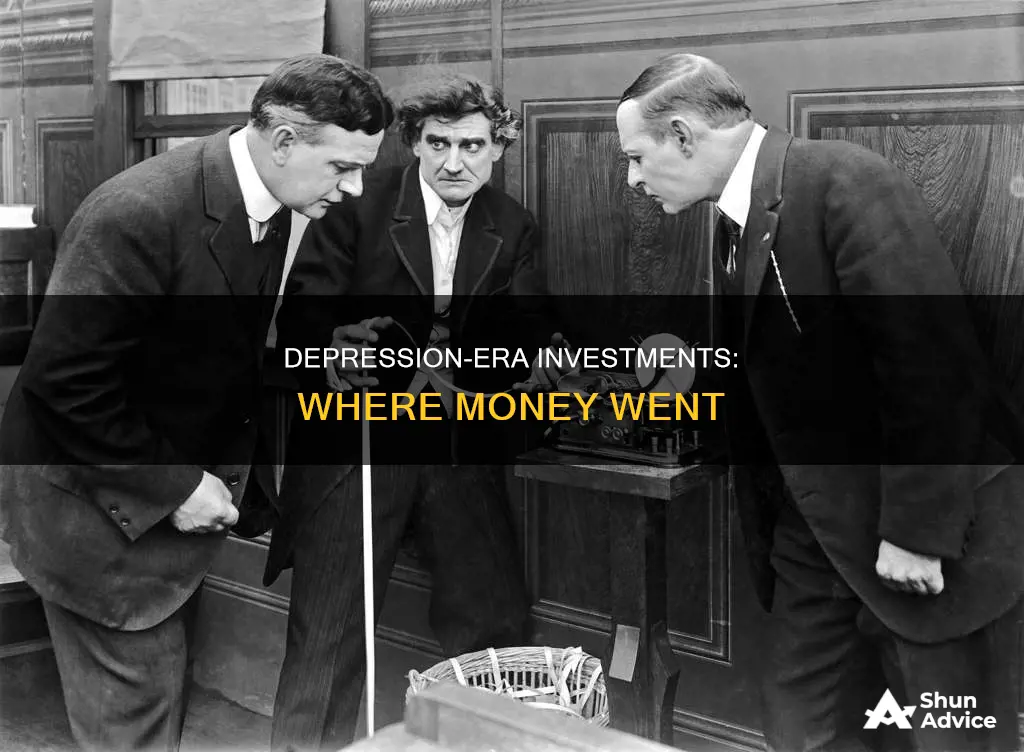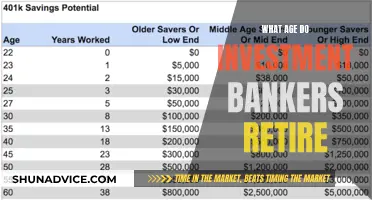
The Great Depression of the 1930s was a time of economic crisis, with the US economy shrinking by over a third from 1929 to 1933. The period was marked by a stock market crash, bank failures, and soaring unemployment. During this time, many lost their fortunes, but a few accumulated vast wealth. So, what did people invest in during the Great Depression?
Well, it's complicated. A diverse range of investments performed well during this turbulent time. Some people invested in stocks, while others favoured government bonds, real estate, or annuities. Diversification was key, as those who held a variety of assets, such as stocks and real estate, fared better than those who put all their money in one place.
A few notable individuals who grew their fortunes during the Great Depression include William Boeing, who built an aviation empire, and Walter Chrysler, who boosted sales of his cheaper Plymouth car brand. Joseph Kennedy, Sr., also profited, thanks to shrewd and often unethical stock market moves, as well as investments in the film industry and liquor imports. Oil tycoon J. Paul Getty snapped up undervalued oil stocks and real estate, while Howard Hughes inherited a fortune and expanded his wealth through film production and aviation.
Overall, the Great Depression was a time of high-risk, high-reward investments, where a few savvy individuals managed to turn a profit despite the challenging economic climate.
| Characteristics | Values |
|---|---|
| Investments that did well during the Great Depression | Default-free Treasury bills, Treasury bonds, and some other very high-quality fixed-income securities |
| Stock market performance | The Dow Jones Industrial Average (DJIA) fell from a peak of 381.17 in September 1929 to 41.22 in July 1932, a loss of 89.2% |
| Impact of the stock market crash | Investors and businesses lost significant amounts of money, leading to closed businesses and lost savings |
| Economic impact | The US economy shrank by more than 36% from 1929 to 1933; unemployment rate exceeded 20% |
| Successful investors during the Great Depression | William Boeing, Walter Chrysler, Joseph Kennedy Sr., J. Paul Getty, Mae West, Charles Clinton Spaulding, Michael Cullen, Howard Hughes |
| Investment strategies during the Great Depression | Diversification, cash reserves, avoiding margin investing, market timing, capital preservation, buying bargains |
What You'll Learn
- People invested in stocks on margin, buying assets with a percentage of the asset's value and borrowing the rest
- Some people invested in Treasury bills and bonds, which did well during the Great Depression
- People invested in oil stocks, such as J. Paul Getty who bought undervalued oil stocks
- Some people invested in real estate, such as Joseph Kennedy, Sr. who purchased a failing Hollywood studio
- People invested in commodities, such as corn, which was cheaper than coal

People invested in stocks on margin, buying assets with a percentage of the asset's value and borrowing the rest
During the 1920s, the stock market became a national pastime for many Americans, attracting investors ranging from millionaires to clerks and cab drivers. However, many of these investors did not have substantial capital to invest. This led to the rise of buying stocks on margin, where investors paid only a percentage of the asset's value upfront and borrowed the rest from banks or brokers.
Under the loose rules of the time, investors could purchase stocks by paying as little as 10% of the stock's value and borrowing the remaining 90% from banks or stockbrokers. This allowed investors with limited capital to enter the stock market and participate in the booming economy of the Roaring Twenties. For example, an investor could buy $1,000 worth of stock by paying $100 in cash and borrowing the remaining $900. If the stock value rose to $1,075, the investor made a $75 profit on paper. However, this profit existed only on paper, as the investor still had to repay the borrowed amount with interest, typically at a rate between 14% and 19%.
Margin trading can lead to significant gains in a rising market, as investors can leverage borrowed funds to buy more stock than they could otherwise afford. As a result, when stock prices increased, the gains were magnified by the borrowed funds. However, this strategy also carried significant risks. If the stock value declined, investors not only lost their own investment but also incurred losses on the borrowed funds.
The practice of buying stocks on margin contributed to the stock market crash of 1929, which precipitated the Great Depression. As stock prices began to fall, brokers issued margin calls, demanding that investors repay their loans immediately. Many investors were unable to deposit additional funds, leading to the forced liquidation of their portfolios. This spiral of margin calls and forced liquidations accelerated the downward trajectory of the stock market, exacerbating the financial losses for many Americans.
While the stock market crash of 1929 was a significant event, it was not the sole cause of the Great Depression. Other factors, such as overproduction, oversupply, agricultural overproduction, panic selling, higher interest rates, and a negative media industry, also played a role in the economic downturn.
Who Invests in Precious Metals?
You may want to see also

Some people invested in Treasury bills and bonds, which did well during the Great Depression
During the Great Depression, some people invested in Treasury bills and bonds, which proved to be a sound strategy. While the stock market crash of 1929 devastated many investors, those who turned to Treasury securities benefited from the Federal Reserve's efforts to lower interest rates and inject liquidity into the market.
In 1932, the Federal Reserve implemented quantitative easing by purchasing $1 billion in Treasury securities over two quarters, causing interest rates to plummet. This action not only reduced the risk premium for bond investors but also led to dramatic drops in interest rates on Treasury bills and yields on certificates, notes, and bonds. As a result, Treasury securities outperformed stocks during the Great Depression.
The performance of Treasury bills and bonds during this period can be attributed to the inverse relationship between interest rates and bond prices. When interest rates fall, bond prices rise, and vice versa. During the Great Depression, interest rates declined sharply, causing bond prices to soar. For example, the prime corporate bond yield average decreased from 4.59% in September 1929 to 3.99% in May 1931 and further down to 2.94% in June 1938.
The Federal Reserve's actions in 1932 provide valuable insights into the effectiveness of monetary policy in addressing economic downturns. By purchasing long-term Treasury securities, the Fed was able to significantly reduce interest rates and provide much-needed liquidity to the market. This intervention not only helped investors in Treasury securities but also contributed to the overall economic recovery during the Great Depression.
Overall, the experience of investors during the Great Depression underscores the importance of diversifying one's portfolio and considering alternative investment options beyond the stock market. Treasury bills and bonds offered a safe haven for investors during a turbulent economic period, demonstrating their value as a stable and reliable investment choice.
Who Manages Your Money?
You may want to see also

People invested in oil stocks, such as J. Paul Getty who bought undervalued oil stocks
During the Great Depression, some people were able to accumulate vast fortunes. One such person was oil tycoon J. Paul Getty, who abided by a simple business formula: "Buy when everyone else is selling, and hold on until everyone else is buying."
Getty had already made his first million dollars in the oil industry more than a decade before the Great Depression. During the 1929 Wall Street crash, he skipped a celebration of his parents' golden wedding anniversary to commiserate with Wall Street brokers, investors, and speculators. With companies desperate for cash, Getty snapped up undervalued oil stocks and real estate. "It is the opportunity of a lifetime to get oil companies for practically nothing," he wrote.
Getty aimed to build an oil empire to rival that of John D. Rockefeller. To that end, he purchased the Pacific Western Oil Company and shares of Tide Water Associated Oil Company, the country's ninth-largest oil company. Five years after buying Tide Water shares for $2.12, they were worth more than $20.
Getty's strategy of buying undervalued oil stocks during the Great Depression paid off handsomely. By 1936, he had contributed to the establishment of a $3.3 million investment trust, called the Sarah C. Getty Trust, to ensure the family's ever-growing wealth could be channelled into tax-free, secure income for future generations. This trust gave Getty easy access to capital, which he funnelled into the purchase of more oil stocks, specifically Tidewater Petroleum.
Getty's wealth continued to grow in the following decades. In 1957, Fortune magazine named him the wealthiest living American, and by the time of his death in 1976, he was worth more than $6 billion.
Wyndham's Annual Investor Count
You may want to see also

Some people invested in real estate, such as Joseph Kennedy, Sr. who purchased a failing Hollywood studio
While many people lost their fortunes during the Great Depression, a few, like Joseph Kennedy, Sr., were able to profit from their investments. Kennedy, who had made a fortune in the stock market during the 1920s, used his Wall Street earnings to invest in real estate and the film industry.
In 1926, Kennedy purchased a failing Hollywood studio and began consolidating movie companies, churning out low-budget films, and selling them for a profit. By the time he exited the film industry in 1931, he had earned $5 million. Kennedy's investments in Hollywood paid off, and he emerged from the 1929 stock market crash wealthier than ever.
Kennedy's real estate ventures were also lucrative. He owned residential and commercial properties, with a particular focus on New York City. One of his most important purchases was Chicago's Merchandise Mart, the largest privately-owned building in the country at the time. The revenues from the Merchandise Mart became a principal source of wealth for the Kennedy family. Kennedy also held a majority ownership in the Hialeah Park Race Track in Hialeah, Florida.
In addition to his real estate and film investments, Kennedy ventured into liquor importing as soon as it became legal to do so. He signed a lucrative contract to become the sole American importer of Scotch whisky and gin produced by British distillers such as Dewar's and Gordon's. This contributed to the growth of his wealth, which increased from $4 million in 1929 to an estimated $180 million by 1935.
Kennedy's business acumen and investment strategies allowed him to not only survive but thrive during the Great Depression, and his wealth laid the groundwork for his sons' future political ambitions.
Investments: How Much is Too Much?
You may want to see also

People invested in commodities, such as corn, which was cheaper than coal
During the Great Depression, some people invested in commodities, such as corn, which was cheaper than coal. Corn, along with wheat and other staple foodstuffs, is traded on global commodities markets. These markets are controlled by a few powerful trading companies, such as Cargill, which dominate the trade of commodities like wheat and cattle.
Commodities markets are organised around exchanges, such as the Chicago Board of Trade, where traders buy and sell futures contracts for commodities. A futures contract is an agreement to buy or sell a specific quantity of a commodity at a set price at a future date. These contracts are traded on exchanges, which also set the rules for trading.
During the Great Depression, the price of wheat fell sharply, causing financial hardship for farmers. The price of wheat in Chicago fell from $1.40 per bushel in July 1929 to 49 cents by 1931, a loss of about two-thirds of its value. This was due to a combination of factors, including oversupply, reduced demand, and increased competition from exports in Argentina and Australia.
The Dust Bowl, a severe drought that began in 1933, further exacerbated the situation, causing prices to double by mid-1934. By 1937, 21% of rural families were on emergency government relief, and many farms were forced to change hands.
While the focus of this answer is on commodities, it is worth noting that during the Great Depression, some individuals were able to accumulate vast fortunes through investments in various industries, including aviation, oil, real estate, and entertainment.
Investments: Are They for Everyone?
You may want to see also
Frequently asked questions
People invested in stocks, bonds, real estate, and Treasury bills.
Government bonds and annuities were some of the best-performing investments during the Great Depression.
Joseph Kennedy, Sr., J. Paul Getty, Mae West, Charles Clinton Spaulding, Michael Cullen, and Howard Hughes all made money during the Great Depression.
The aviation, insurance, and movie industries did well during the Great Depression.







